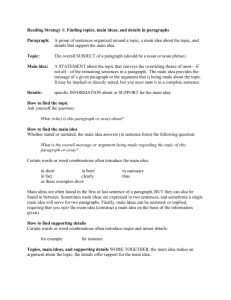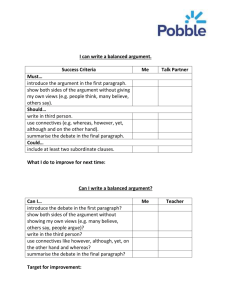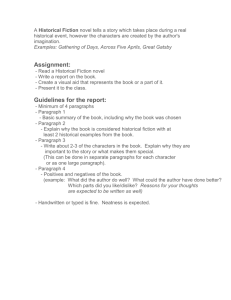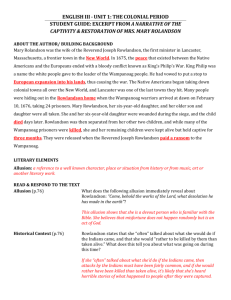Critical Response Paragraphs
advertisement
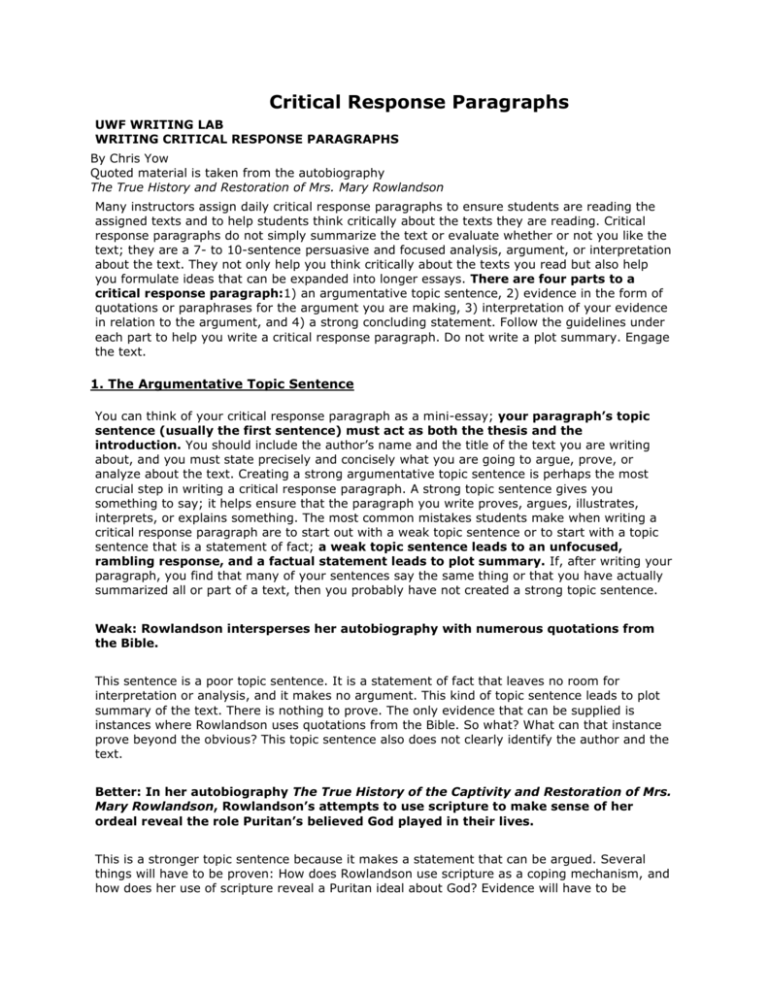
Critical Response Paragraphs UWF WRITING LAB WRITING CRITICAL RESPONSE PARAGRAPHS By Chris Yow Quoted material is taken from the autobiography The True History and Restoration of Mrs. Mary Rowlandson Many instructors assign daily critical response paragraphs to ensure students are reading the assigned texts and to help students think critically about the texts they are reading. Critical response paragraphs do not simply summarize the text or evaluate whether or not you like the text; they are a 7- to 10-sentence persuasive and focused analysis, argument, or interpretation about the text. They not only help you think critically about the texts you read but also help you formulate ideas that can be expanded into longer essays. There are four parts to a critical response paragraph:1) an argumentative topic sentence, 2) evidence in the form of quotations or paraphrases for the argument you are making, 3) interpretation of your evidence in relation to the argument, and 4) a strong concluding statement. Follow the guidelines under each part to help you write a critical response paragraph. Do not write a plot summary. Engage the text. 1. The Argumentative Topic Sentence You can think of your critical response paragraph as a mini-essay; your paragraph’s topic sentence (usually the first sentence) must act as both the thesis and the introduction. You should include the author’s name and the title of the text you are writing about, and you must state precisely and concisely what you are going to argue, prove, or analyze about the text. Creating a strong argumentative topic sentence is perhaps the most crucial step in writing a critical response paragraph. A strong topic sentence gives you something to say; it helps ensure that the paragraph you write proves, argues, illustrates, interprets, or explains something. The most common mistakes students make when writing a critical response paragraph are to start out with a weak topic sentence or to start with a topic sentence that is a statement of fact; a weak topic sentence leads to an unfocused, rambling response, and a factual statement leads to plot summary. If, after writing your paragraph, you find that many of your sentences say the same thing or that you have actually summarized all or part of a text, then you probably have not created a strong topic sentence. Weak: Rowlandson intersperses her autobiography with numerous quotations from the Bible. This sentence is a poor topic sentence. It is a statement of fact that leaves no room for interpretation or analysis, and it makes no argument. This kind of topic sentence leads to plot summary of the text. There is nothing to prove. The only evidence that can be supplied is instances where Rowlandson uses quotations from the Bible. So what? What can that instance prove beyond the obvious? This topic sentence also does not clearly identify the author and the text. Better: In her autobiography The True History of the Captivity and Restoration of Mrs. Mary Rowlandson, Rowlandson’s attempts to use scripture to make sense of her ordeal reveal the role Puritan’s believed God played in their lives. This is a stronger topic sentence because it makes a statement that can be argued. Several things will have to be proven: How does Rowlandson use scripture as a coping mechanism, and how does her use of scripture reveal a Puritan ideal about God? Evidence will have to be provided and interpreted to support this claim. This topic sentence also clearly identifies the author and the text. 2 and 3. Evidence and Interpretation Now that you have created a strong argumentative topic sentence, how do you prove your argument? Quotations and paraphrases from the text supply the evidence you need to support your argument. You may want to go through the text and mark or write down passages that illustrate what you are trying to prove. From these passages, choose one or two that most clearly support your argument. There may be more, but in a 7-10 sentence paragraph, you do not have the space to incorporate all of them, so choose the best. Filling your paragraph with evidence does nothing to prove your argument, however. When you use a quote or a paraphrase, you must interpret or explain it in relation to your argument; evidence does not stand alone as proof. In addition to interpreting your evidence, you must also smoothly incorporate it into your paragraph. Introducing your evidence is the best way to incorporate it into your paragraph; introducing the evidence tells the reader from where in the text the passage is taken, and it helps highlight what you are using the evidence to prove. Unclear: Rowlandson dismisses her hardships as a trial by God. “Affliction I wanted, and Affliction I had, full measure. [. . .] And I hope I can say in some measure as David did, It is good for me that I have been afflicted” (69). This example may use an excellent passage from the text, but the passage is not explained or interpreted. It is also not introduced and seems dropped into the paragraph. Better: Rowlandson uses scripture as a way to illuminate God’s motives; she uses scripture to explain why she has to endure seemingly senseless hardships. Near the end of the narrative, Rowlandson writes, “Affliction I wanted, and Affliction I had, full measure. [. . .] And I hope I can say in some measure as David did, It is good for me that I have been afflicted” (69). This example shows how Rowlandson compares her ordeals to the ordeals of Biblical figures. She is able to understand her hardships as trials and tests by God to strengthen her faith. Notice that the same quotation from the previous example is used again. However, it is now more smoothly integrated into the paragraph, and it is now interpreted in relation to the argument. Notice also how much longer this example is than the previous one.Properly introducing your evidence and interpreting it becomes the bulk of your paragraph. Add your topic sentence and a concluding statement, and you’ve written a critical response paragraph. 4. Concluding Statement Don’t allow your paragraph to putter out at the end or to stop abruptly after you’ve proven your argument. You’ve stated your argument, supplied evidence to support it, and interpreted the evidence. End your paragraph with a strong concluding sentence that restates your topic sentence and brings all of your thoughts together into a final comment about the text. Weak: Using scripture, Rowlandson is able to make sense out of the hardships she endures. Better: Rowlandson’s attempt to explain her hardships through scripture reveals the Puritan view that God is an omnipresent influence in daily life and that everything that happens serves God’s purpose, whether or not that purpose can be understood. Some Things to Keep in Mind List of Questions Many instructors provide a list of questions as critical response paragraph topics. Use these questions to create a topic sentence. Generally, if you can write a one-sentence answer to the question, you’ve created a topic sentence. Length Most critical response paragraphs are between 7 and 10 sentences in length. Any shorter and you probably have not used enough space to prove your argument; any longer and you probably have lost focus and drifted outside the scope of your argument. Format Format your paragraph using MLA format. Your instructor may not require it for critical paragraphs, but the practice will help you when you write a formal essay. Parenthetical Documentation Always document the page number(s) you quote or paraphrase using MLA parenthetical documentation style. Your instructor may not require a works cited page, but most instructors do want to know from where the material is taken and that you can demonstrate proper documentation technique. Not documenting your sources risks plagiarism. The “So what?” Test Your topic sentence and your paragraph should be able to pass the “So what?”test. When you’ve made a statement, ask yourself, “So what?” If you can’t provide an answer, then you probably have not made a strong argument. Proofreading and Editing Always proofread, edit, and revise. Silly mistakes, awkward sentences, and poor grammar detract from the authority you are trying to create to prove your argument. They will also cost you points on your grade that could be easily avoided. Two very good ideas to help you revise your paragraph are to read it out loud to yourself and to have someone else proofread it for you. Two Example Paragraphs Example 1: A Plot Summary (Don’t Do This) Rowlandson intersperses her autobiography with numerous quotations from the Bible. She seems to use the quotations to try to make sense of her ordeal. In one section, she dismisses her hardships as a trial by God. “Affliction I wanted, and Affliction I had, full measure. [. . .] And I hope I can say in some measure as David did, It is good for me that I have been afflicted” (69). Using scripture, Rowlandson is able to make sense out of the hardships she endures. Example 2: A More Engaging Paragraph In her autobiography, The True History of the Captivity and Restoration of Mrs. Mary Rowlandson, Rowlandson’s attempts to use scripture to make sense of her ordeal reveal the role Puritan’s believed God played in their lives. Rowlandson uses scripture as a way to illuminate God’s motives; she uses scripture to explain why she has to endure seemingly senseless hardships. Near the end of the narrative, Rowlandson writes, “Affliction I wanted, and Affliction I had, full measure. [. . .] And I hope I can say in some measure as David did, It is good for me that I have been afflicted” (69). This example shows how Rowlandson compares her ordeals to the ordeals of Biblical figures. She is able to understand her hardships as trials and tests by God to strengthen her faith. Rowlandson’s attempt to explain her hardships through scripture reveals the Puritan view that God is an omnipresent influence in daily life and that everything that happens serves God’s purpose, whether or not that purpose can be understood.

